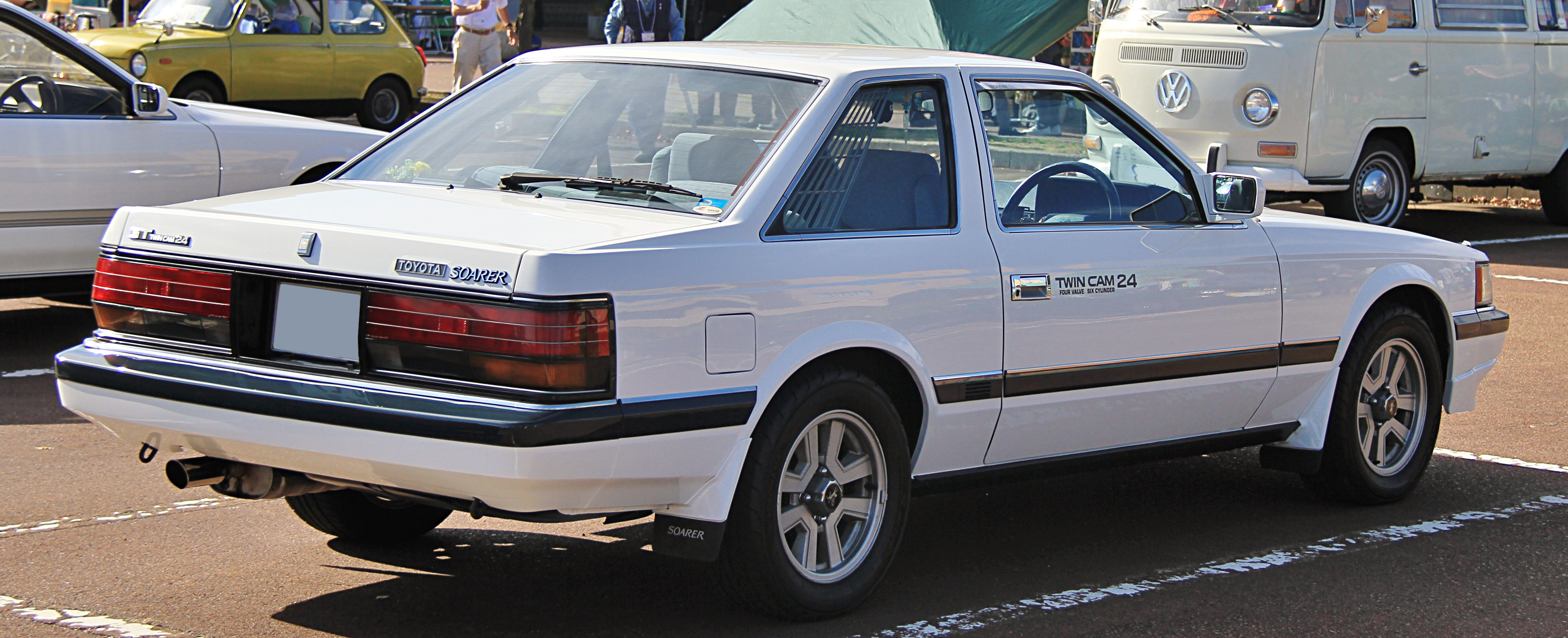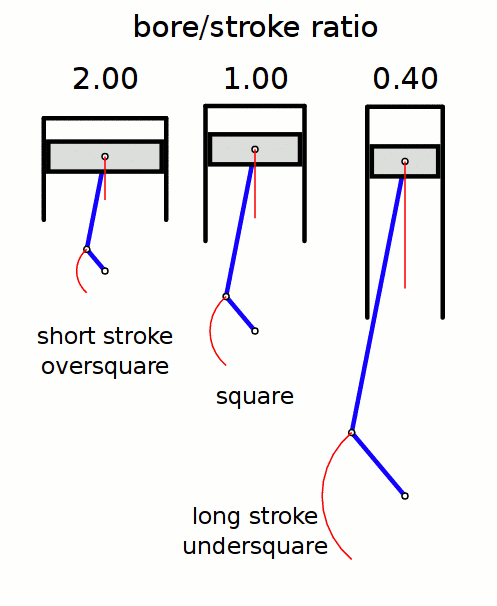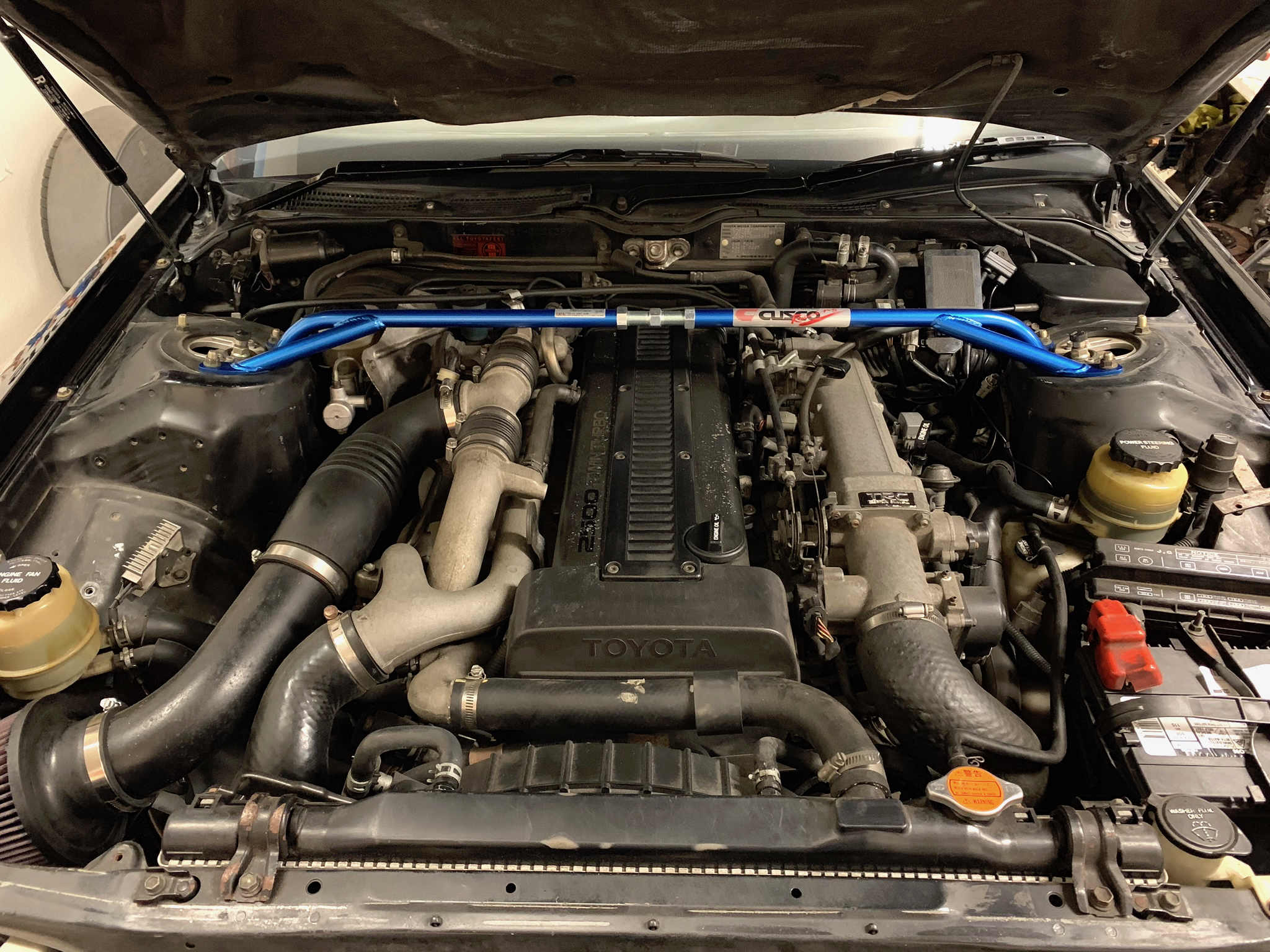|
Toyota G Engine
The Toyota Motor Corporation G-family engine is a family of straight-6 piston engines produced from 1979 to 2008. It is notable in that only a single displacement, , was produced in this series. Initially belt-driven OHC non-interference engines (except the VVT-i version which is an interference engine), multivalve DOHC (except the 1G-EU SOHC 12 valve engine) and variable valve timing were added later during the production run. The 1G-GEU was Toyota's first mass produced four-valve twincam engine. A prototype version of the 1G-GEU called the LASREα–X, featuring twin-turbos, variable valve timing and intake as well as variable displacement, was fitted to the Toyota FX-1 show car at the 1983 Tokyo Motor Show. It showcased a number of technologies which were later to become commonplace. These engines were used as a lower-displacement alternative to the more upmarket M family and JZ family straight-sixes. For ten months (in 1967-1968), Toyota also offered Hino's GR100 ... [...More Info...] [...Related Items...] OR: [Wikipedia] [Google] [Baidu] |
Toyota Motor Corporation
is a Japanese multinational automotive manufacturer headquartered in Toyota City, Aichi, Japan. It was founded by Kiichiro Toyoda and incorporated on . Toyota is one of the largest automobile manufacturers in the world, producing about 10 million vehicles per year. The company was originally founded as a spinoff of Toyota Industries, a machine maker started by Sakichi Toyoda, Kiichiro's father. Both companies are now part of the Toyota Group, one of the largest conglomerates in the world. While still a department of Toyota Industries, the company developed its first product, the Type A engine in 1934 and its first passenger car in 1936, the Toyota AA. After World War II, Toyota benefited from Japan's alliance with the United States to learn from American automakers and other companies, which would give rise to The Toyota Way (a management philosophy) and the Toyota Production System (a lean manufacturing practice) that would transform the small company into a leader i ... [...More Info...] [...Related Items...] OR: [Wikipedia] [Google] [Baidu] |
Variable Valve Timing
In internal combustion engines, variable valve timing (VVT) is the process of altering the timing of a valve lift event, and is often used to improve performance, fuel economy or emissions. It is increasingly being used in combination with variable valve lift systems. There are many ways in which this can be achieved, ranging from mechanical devices to electro-hydraulic and camless systems. Increasingly strict emissions regulations are causing many automotive manufacturers to use VVT systems. Two-stroke engines use a power valve system to get similar results to VVT. Background theory The valves within an internal combustion engine are used to control the flow of the intake and exhaust gases into and out of the combustion chamber. The timing, duration and lift of these valve events has a significant impact on engine performance. Without variable valve timing or variable valve lift, the valve timing is the same for all engine speeds and conditions, therefore compromises are neces ... [...More Info...] [...Related Items...] OR: [Wikipedia] [Google] [Baidu] |
Toyota Supra
is a sports car and grand tourer manufactured by the Toyota Motor Corporation beginning in 1978. The name "supra" is derived from the Latin prefix, meaning "above", "to surpass" or "go beyond". The initial four generations of the Supra were produced from 1978 to 2002. The fifth generation has been produced since March 2019 and went on sale in May 2019. The styling of the original Supra was derived from the Toyota Celica, but it was both longer and wider. Starting in mid-1986, the A70 Supra became a separate model from the Celica. In turn, Toyota also stopped using the prefix ''Celica'' and named the car ''Supra''. Owing to the similarity and past of the Celica's name, it is frequently mistaken for the Supra, and vice versa. The first, second and third generations of the Supra were assembled at the Tahara plant in Tahara, Aichi, while the fourth generation was assembled at the Motomachi plant in Toyota City. The 5th generation of the Supra is assembled alongside the G29 BMW Z4 i ... [...More Info...] [...Related Items...] OR: [Wikipedia] [Google] [Baidu] |
Toyota Soarer
The is a personal luxury GT coupé produced from 1981 to 2005 by Toyota and sold in Japan. It was available at both Japanese Toyota dealerships called ''Toyota Store'' and ''Toyopet Store'', and it debuted with the Z10 series, replacing the ''Toyopet Store'' exclusive Mark II coupé, and the ''Toyota Store'' exclusive Crown coupé. In 1986, the Z20 series Soarer was launched, based on the then new A70 series Supra platform. In 1991, the Z30 series Soarer premiered in Japan, while its Lexus equivalent, the SC 300/400 debuted in the US market. While externally identical to the SC, the Z30 series Soarer lineup offered different powertrain specifications and multiple unique vehicle configurations. In 2001, Toyota introduced a convertible-only successor in Japan as the Z40 series Soarer and elsewhere as the SC 430. In contrast to previous series, the Z40 series Soarer and SC were based on a single model and were largely equivalent. In 2005, following the introduction of Lexus i ... [...More Info...] [...Related Items...] OR: [Wikipedia] [Google] [Baidu] |
Stroke Ratio
In a reciprocating piston engine, the stroke ratio, defined by either bore/stroke ratio or stroke/bore ratio, is a term to describe the ratio between cylinder bore diameter and piston stroke length. This can be used for either an internal combustion engine, where the fuel is burned within the cylinders of the engine, or external combustion engine, such as a steam engine, where the combustion of the fuel takes place ''outside'' the working cylinders of the engine. A fairly comprehensive yet understandable study of stroke/bore effects was published in ''Horseless Age'', 1916. Conventions In a piston engine, there are two different ways of describing the ''stroke ratio'' of its cylinders, namely: ''bore/stroke'' ratio, and ''stroke/bore'' ratio. Bore/stroke ratio Bore/stroke is the more commonly used term, with usage in North America, Europe, United Kingdom, Asia, and Australia. The diameter of the cylinder bore is divided by the length of the piston stroke to give the rati ... [...More Info...] [...Related Items...] OR: [Wikipedia] [Google] [Baidu] |
Hino Contessa
The Hino Contessa is an automobile which was produced by Hino Motors from 1961 to 1967. The Contessa was developed largely from the 1947-1961 Renault 4CV powertrain under license to Hino Motors. Offered in both coupe and sedan bodystyles, it replaced the Hino Renault, which was the Renault 4CV manufactured by Hino for Japan. It was adapted into a small pickup truck called the Hino Briska, but used a front engine and rear drive powertrain, while the Contessa used a rear engine and rear drive setup. The PC series coupé was designed by Giovanni Michelotti, while the second generation was longer and wider in both coupé and sedan bodystyles. Unlike many cars found internationally of this time period, using rear drive and rear engined powertrains, the Contessa was water-cooled rather than air-cooled. The name ''contessa'' is Italian for a countess. PC series (1961-1964) 47,299 of the PC-series Contessa were built, between April 1961 and the second quarter of 1964. With an 893&nb ... [...More Info...] [...Related Items...] OR: [Wikipedia] [Google] [Baidu] |
Renault
Groupe Renault ( , , , also known as the Renault Group in English; legally Renault S.A.) is a French multinational automobile manufacturer established in 1899. The company produces a range of cars and vans, and in the past has manufactured trucks, tractors, tanks, buses/coaches, aircraft and aircraft engines, and autorail vehicles. According to the Organisation Internationale des Constructeurs d'Automobiles, in 2016 Renault was the ninth biggest automaker in the world by production volume. By 2017, the Renault–Nissan–Mitsubishi Alliance had become the world's biggest seller of light vehicles. Headquartered in Boulogne-Billancourt, near Paris, the Renault group is made up of the namesake Renault marque and subsidiaries, Alpine, Renault Sport (Gordini), Automobile Dacia from Romania, and Renault Samsung Motors from South Korea. Renault has a 43.4% stake with several votes in Nissan of Japan, and used to have a 1.55% stake in Daimler AG of Germany, it was sold off in ... [...More Info...] [...Related Items...] OR: [Wikipedia] [Google] [Baidu] |
Overhead Valve Engine
An overhead valve (OHV) engine, sometimes called a ''pushrod engine'', is a piston engine whose valves are located in the cylinder head above the combustion chamber. This contrasts with earlier flathead engines, where the valves were located below the combustion chamber in the engine block. Although an overhead camshaft (OHC) engine also has overhead valves, the common usage of the term "overhead valve engine" is limited to engines where the camshaft is located in the engine block. In these traditional OHV engines, the motion of the camshaft is transferred using pushrods (hence the term "pushrod engine") and rocker arms to operate the valves at the top of the engine. Some early intake-over-exhaust engines used a hybrid design combining elements of both side-valves and overhead valves. History Predecessors The first internal combustion engines were based on steam engines and therefore used slide valves. This was the case for the first Otto engine, which was first succe ... [...More Info...] [...Related Items...] OR: [Wikipedia] [Google] [Baidu] |
Hino Briska
The was a small pickup truck built by Hino Motors, adapted from the Renault-based Hino Contessa sedan. It was first introduced in 1961 and remained in production until 1968, when Toyota released the Toyota Hilux. In 1967, the Hino Briska was renamed the Toyota Briska, then the Hilux was introduced, based on the Briska. There was also a commercial delivery van, appropriately called the . __TOC__ FG series; 1961-1965 The Briska was introduced in March 1961 at exhibitions in 32 cities across Japan. Called the FG10, it used a Hitachi-Stromberg carburetor on a modified version of the Contessa's engine, itself derived from that of the Renault 4CV. In March 1962, the Briska lineup added a longer version with a second bench seat for rear seat passengers. This was coded FG20P and was also available in a glazed van version ("Light Van"), called FG20V.Ozeki, p. 109 The Briska was built under contract by rather than by Hino themselves from the beginning. The body style with the single b ... [...More Info...] [...Related Items...] OR: [Wikipedia] [Google] [Baidu] |
Hino Motors
Hino Motors, Ltd., commonly known as Hino, is a Japanese manufacturer of commercial vehicles and diesel engines (including those for trucks, buses and other vehicles) headquartered in Hino, Tokyo. The company was established in 1942 as a corporate spin-off from previous manufacturers. Hino Motors is a large constituent of the Nikkei 225 on the Tokyo Stock Exchange. It is a subsidiary of Toyota Motor Corporation and one of 16 major companies of the Toyota Group. History The company traces its roots back to the founding of Tokyo Gas Industry Company in 1910. In 1910, Chiyoda Gas Company was established and competed fiercely against incumbent Tokyo Gas Company for gas lighting users. Tokyo Gas Industry was a parts supplier for Chiyoda Gas but it was defeated and merged into Tokyo Gas in 1912. Having lost its largest client, Tokyo Gas Industry Co. broadened its product line including electronic parts, and renamed itself as Tokyo Gas and Electric Industry (東京瓦斯電気工業 ... [...More Info...] [...Related Items...] OR: [Wikipedia] [Google] [Baidu] |
Toyota JZ Engine
The Toyota JZ engine family is a series of inline-6 automobile engines produced by Toyota Motor Corporation. As a replacement for the M-series inline-6 engines, the JZ engines were 24-valve DOHC engines in 2.5- and 3.0-litre versions. 1JZ The 1JZ version was produced from 1990 to 2007 (last sold in the Mark II BLIT Wagon and Crown Athlete). Cylinder bore and stroke is . It is a 24-valve DOHC engine with two belt-driven camshafts and a dual-stage intake manifold. 1JZ-GE The 1JZ-GE is a common version, with a 10:1 compression ratio. Output for the early non-turbo, non-VVT-i (1990–1995) 1JZ-GE was at 6000 rpm and at 4800 rpm. VVT-i variable valve timing was added in 1995, for an output of at 6000 rpm and at 4000 rpm. Like all JZ-series engines, the early 1JZ-GE is designed for longitudinal mounting and rear-wheel-drive. All of these models only came with a 4-speed automatic transmission; no manual gearbox option was offered. 1JZ-GTE The 1JZ-G ... [...More Info...] [...Related Items...] OR: [Wikipedia] [Google] [Baidu] |
Toyota M Engine
Toyota Motor Corporation's M family of engines were a longitudinally mounted straight-6 engine design. They were used from the 1960s through the 1990s. All M family engines were OHC designs. While the M family was born with a chain-driven single camshaft it evolved into a belt drive DOHC system after 1980. All M family engines used a cast-iron block with an aluminum cylinder head, and were built at the Toyota Kamigo plant in Toyota City, Japan. The M-E variant, available only in the Japanese domestic market, was the first Toyota engine to be equipped with fuel injection (at the same time as the 4-cylinder 18R-E). The 4M-E was the first Toyota engine to be equipped with fuel injection for non-Japanese markets. The M family were Toyota's most prestigious engines (apart from the uncommon '' V family'' V8) for 30 years. They were commonly found on the large Toyota Crown, Mark II, and Supra models. M The first M was a version produced from 1965 through 1988. It was a 2-va ... [...More Info...] [...Related Items...] OR: [Wikipedia] [Google] [Baidu] |









